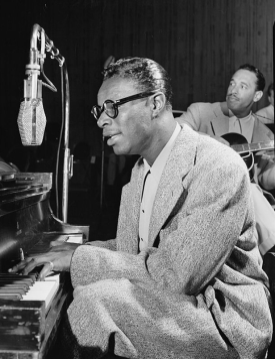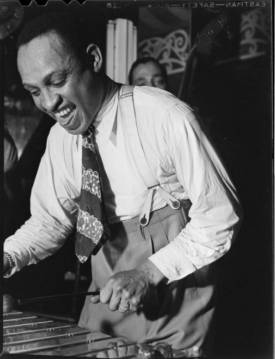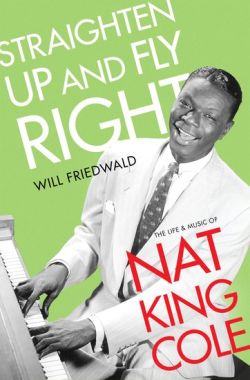.
.
“Great Encounters” are book excerpts that chronicle famous encounters among twentieth-century cultural icons. In this edition, Will Friedwald, author of Straighten Up and Fly Right: The Life and Music of Nat King Cole, writes about the 1940 Lionel Hampton/King Cole Trio RCA Victor recording sessions.
.
.
Excerpted from STRAIGHTEN UP AND FLY RIGHT by Will Friedwald. Copyright 2020 by Will Friedwald and published by Oxford University Press. All rights reserved.
.
.
___
.
.
photo by William Gottlieb/Library of Congress

Nat King Cole and Oscar Moore, New York, N.Y., ca. July 1946
.
.
photo by William Gottlieb/Library of Congress

Lionel Hampton, Aquarium, New York, N.Y., ca. June 1946
.
___
.
DURING COLE’S 1954 TOUR of England, a local journalist and jazz buff asked him about the eight remarkable sides he cut with Lionel Hampton in 1940. “Golly, you remember those? This was while Hamp was still with Goodman. He heard the Trio one night on a club date, and thought he’d like to cut some records with us as his rhythm section.”
…..In September 1939, Down Beat had reported that while the Goodman orchestra was in Los Angeles, Hampton, as we know, “was out every night playing two-finger piano with King and his boys” at the Swanee Inn. This makes sense: Hampton was rushing out after the Goodman gigs, and rather than dealing with the vibraphone or drums (there was no room for them on the Swanee bandstand in any case) he just sat next to Nat and played the piano as if it were a vibraphone and his fingers were mallets, two notes at a time. He told Down Beat at the time that he was already planning to “use the Trio on some records soon.”
…..In April 1940, the Goodman Orchestra was back in LA, playing the Palomar and recording for Columbia. On Thursday, April 10, Hampton played on a famous session with Goodman and Fred Astaire in the afternoon, but a few hours later, he was part of an equally auspicious team-up, when he guest starred with the Trio, for the only time in front of a general paying audience (as opposed to jamming after hours at the Paradise and at the Swanee). That evening, some enterprising producer was staging a “fastmoving, all-colored revue” done in the style of a Harlem nightclub at Los Angeles City College. “The King Cole Swing Trio” was on the bill, along with a roster of singers, dancers, and a big band. To the surprise and delight of the crowd, however, the biggest hit of the program was scored by Lionel Hampton, making a surprise appearance. “A program of jam and jive, [featuring] the guest appearance of the one and only Lionel Hampton, had the ancient L. A. City College Auditorium in an uproar last Thursday,” the California Eagle reported. “It remained for ‘Popsie’ Hampton, sitting in with the King Cole Trio, Nat Cole, Wesley Prince and Oscar Moore, to break up the show. His jamming the vibes on ‘Flying Home’ and ‘Moonglow,’ piano solo and drumming, had the campus agog for the rest of the day.”
…..The combination of Hampton and the King Cole Trio was too good not to be recorded. Hampton was currently making a series of all-star sessions for RCA Victor, using different musicians from various bands (including Ellington and Basie) as they happened to be in town. In May and July they would record eight titles total, using the Cole Trio as the core group, adding Hampton (mostly on vibraphone), and drummer Al Spieldock. Most of the eight numbers are Hampton originals, and six are instrumentals—Helen Forrest, one of the leading “canaries” of the big band era, then working with Goodman, sings on two, “I’d Be Lost without You” and the standard “Ghost of a Chance.” Claire Phillips was on hand as a timekeeper to make sure that none of these free-wheeling jam sessions exceeded the standard 78 RPM single playing time of three minutes.
…..Unlike the mystery drummer on the Ammor-Varsity titles, Hampton and Spieldock know enough not to try playing in the middle of the Cole-Moore-Prince sonic equation but rather to play around it. In fact, they balance each other, with Hampton’s vibes on the top of the sonic spectrum and Spieldock’s bass drum on the low end. The two guest players frame the three regulars, rather like a pair of parentheses, and, unlike the Ammor drummer, never get in their way. Ever the showman, Hamp also takes solos on piano and drums.
…..Spieldock is, at best, a footnote to jazz history, known for two things: his work on these sessions and being married at the time to Helen Forrest. His playing, mostly on brushes, is superb here, and Hampton’s is even more so. And even though Hampton already had a reputation as a show-boating, scene-stealing kind of a player—and he is, after all, the dominant instrumental voice—he’s frequently generous enough to cede the spotlight to Cole as well as the general direction of the ensemble.
…..There’s a lot of blues here, at nicely varied tempos. The opener, “House of Morgan,” is a pun on the famous banking family and a dedication to the leader’s uncle, Prohibition liquor-entrepreneur Richard Morgan, who had introduced his not-yet-famous nephew to his famous paramour, Bessie Smith. “House of Morgan” is medium fast, but “Jack the Bellboy” is much faster, climaxing in a full-on solo by Hampton. “Central Avenue Breakdown” is a spotlight for Hampton’s famous two-finger style keyboard soloing, a highly entertaining device that he used to goose audiences for many generations, only this time we can hear Cole playing more full-fingered piano accompaniment in the background.
…..Conversely, “Blue” isn’t a blues at all, but a rather lyrical pop song from the book of Earl Hines. “House of Morgan” and “Jack the Bellboy” come off like the Trio guesting on a Hampton date, but the two harmony vocals, “Dough-Rey-Mi” and “Jivin’ with Jarvis,” sound like King Cole Trio records with Hampton making a guest appearance. They were billed on the original RCA labels as the “Hampton Rhythm Boys”—the vocal on the latter is just chanting the title at the start of each A .section (and introducing a scat break by Hampton), but that’s all that’s necessary.
…..The group also plays beautifully behind Forrest on her two ballad vocals— she is easily the best female singer they would accompany, at least up to Anita O’Day in 1944. Which brings up another point: Hampton later wrote of Cole, “I liked his style of piano playing, but even more I.liked his singing. .I was the one who kept telling him, ‘Man, you sing, you sing.’ I .knew he could sell the public on his singing.” Which naturally enough begs the question: Hampton being the leader, why didn’t he ask Cole to sing on “I’d Be Lost without You” and “Ghost of a Chance”—or even “Blue (Because of You?)”
…..The eight titles are overall superb, so much so that one of Cole’s favorite bandleaders, the great Jimmie Lunceford, paid him the honor of commissioning a big band orchestration of “Jivin’ with Jarvis.” Hampton and Cole also continued to “jam” together at the Casa Manana “Monday Night Jamboree,” one Monday in August, in the middle of Lunceford’s gig there.
…..The recordings were so well received that some people started getting ideas. Journalist Leonard Feather, writing in Down Beat, reported that Hampton was organizing his own orchestra and “The King Cole Trio, famed nightery unit, will be incorporated in the new combination.” Hampton later denied that this was ever his idea and suggested instead that Feather was the one who was lobbying for a permanent Hampton-Cole combination. “I had plans for a new band that did not include Nat’s kind of sound. Besides, I .wasn’t planning on a featured singer, and I. knew that’s where Nat’s real popularity was going to come.” However, Nat himself remembered that it was indeed Hamp’s idea that they should keep on working together. “Then Hamp formed his own band and wanted us to join en bloc. Well, sir, we’d just got the Trio going, and I. just didn’t know. I .dickered with the idea, and finally asked Count Basie for some advice. Bill said I’d be damn silly, all those fine things we were starting to do within the group would be blasted out by Hamp’s powerhouse stuff. So we didn’t join.” He was right, the Trio’s kind of “chamber jazz,” which they were featuring on the November 1940 sessions for Standard, was just not Hampton’s “kind of sound”; the vibraphonist and showman’s big band would be much louder, much less subtle, and highly oriented toward raucous R&B-centric dance music.
…..To give Hamp credit, he later did much to help “discover” such essential vocalists as Dinah Washington and Joe Williams. But, in his rather dubious memoir, he made all kinds of audacious claims:. by his account, he was not only the one who encouraged Nat to sing, but he was also responsible for getting Capitol Records to record Nat doing “Straighten Up and Fly Right”; Capitol, he said, only did so as a personal favor to him. This is likely more than a bit of an exaggeration. But then again, perhaps it’s not a coincidence that between the two Hampton sessions, in June 1940, the Trio played at the opening of a new music store on Sunset and Vine; “Music City,” as it was called, was owned and operated by Glenn Wallichs (and his father Oscar). It’s altogether likely that Johnny and Ginger Mercer were there for the opening. As Dave Dexter Jr. later remembered, “Glenn Wallichs was running this music shop at Sunset and Vine, in Hollywood, called ‘Music City.’ It was without a doubt the most successful retailing venture in the record business west of Chicago. Johnny Mercer used to come in, buy his records [presumably meaning records of his songs], sit around and play records he wanted to hear.”
…..Whatever Lionel Hampton’s actual role in the King Cole Story—beyond the great sessions of 1940—and apart from whatever Hamp wanted to take credit for, as it happened, Cole did make his first contact with Wallichs at the very moment he was working with Hamp.
.
___
.
Excerpted from STRAIGHTEN UP AND FLY RIGHT by Will Friedwald. Copyright 2020 by Will Friedwald and published by Oxford University Press. All rights reserved.
.
.
___
.
.
Listen to “Jivin’ With Jarvis”
.
.
.









































very informative…but this article does not mention the 78 I have with nats trio with Lionel on drums…playing ring dem bells…..what a recording